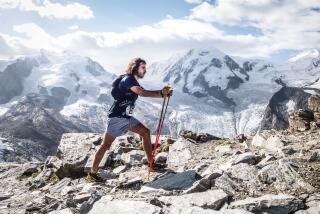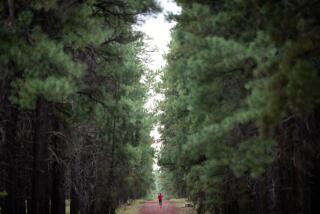123 Degrees, 135 Miles and Hours of Pain--a Case Study in Endurance
- Share via
DEATH VALLEY — Five hours from Los Angeles, spitting distance from hell, Death Valley’s highest recorded temperature of 134 degrees was topped just once, in Libya.
On Tuesday it was a scant 123 as 79 invited athletes completed the first day of the Badwater Ultramarathon, a 135-mile ordeal that tests legs, lungs and reeling psyches.
By the time the first runner finished Wednesday morning at more than 8,000 feet on the haunches of Mt. Whitney, several competitors had doubled over with dry heaves; one rolled in the desert dust, far off the course; and another told of hallucinations--the flying saucers seemed to just hang there, over the desert floor.
Yet there were dozens of individual triumphs too--most notably the first victory by a woman in the 25 years since the race began. Pam Reed, 41, of Arizona arrived at Whitney Portal just before 10 a.m., winning one of the world’s most grueling foot races in just under 28 hours.
This raises obvious but still profound questions: Why? And, how?
Enter a team of British researchers. Catching an early wave of an evolving science, the scientists spent this week developing some of the first psychological and physiological profiles of these ultra-athletes.
Members of the British team believe mega-distance runners have much to share--beyond, that is, making the outside world feel remarkably sedentary.
Exercise physiologists studied earlier generations of elite athletes--confirming, for instance, the benefits of high-altitude training. Now there is a new breed of athlete to offer clues about the limits of human endurance.
“This is how we learn about humans,” said one of the researchers, Murray Griffin, a sports psychology lecturer at the University of Essex. “If we want to study intelligence, you find the smartest people out there. You study the extremes. It brings into focus what normal people, so to speak, are like.”
Last weekend, researchers from the Anglia Polytechnic University in Cambridge took baseline tests of two racers: Marshall Ulrich, 51, a pet food wholesaler from Colorado, and Lisa Smith-Batchen, 42, a personal trainer and coach from Idaho.
The tests, conducted in Las Vegas, created a profile of the athletes.
Additional tests were being conducted this week during the event, and a final round will be conducted at the finish line, 8,360 feet up Mt. Whitney, the tallest peak in the continental U.S.
Ulrich and Smith-Batchen seemed like the right subjects--reaching for goals extreme even within their rarefied subculture.
Later this week, Smith-Batchen expects to complete her first “double.” After finishing the race sometime this morning, she’ll turn around and run back to the starting line in Death Valley, the lowest point in the Western Hemisphere. (She’s doing it for kicks and money, soliciting donations for a religious order that assists impoverished women and children.)
That will be the equivalent of running nearly 10 consecutive marathons, through the hottest territory in America.
Ulrich topped even that feat a year ago--becoming the first person to finish the Badwater course four times in a row. That took 10 days, during which he slept an average of 1 1/2 hours a night.
Two years ago, he pulled another stunner--becoming the first person to complete the race without a crew and support van. Ulrich dragged his own gear, including 21 1/2 gallons of water, in a 212-pound cart. He finished in 77 hours, 48 minutes.
“There are no guarantees this is healthy,” said another of the researchers, Dr. Ralph Beneke of the University of Essex. “There is something different about them.”
But what? Racers themselves have a hard time explaining what they get out of events like the Badwater. They often talk of “learning about myself,” but seem stumped when asked to explain further.
“Why do you climb Everest?” asked Ben Jones, a three-time Badwater participant who is now the event’s unofficial “mayor.” “It’s like [explorer George] Mallory said: Because it’s there. Well, the race is here.”
The researchers are hoping to move beyond that explanation.
Physically, among other things, they will study the athletes’ body temperatures, rate of dehydration and bodily functions. Also to be examined are enzymes that indicate how certain cells die during the race.
Even preliminary results of the tests won’t be available for weeks. But the scientists are already on their way: They have learned, for example, that Smith-Batchen and Ulrich have 20% higher energy efficiency--measured by developing an index that combines oxygen intake, carbon dioxide output and other factors--than other distance runners.
Mentally, the researchers will use standard diagnostic tests to measure factors such as self-esteem. They will test cognitive functioning by asking logic questions. For example, the athletes are told that “A” precedes “B.” Then they will be given the pattern “AB”--which follows that equation--and will be asked to determine whether that pattern is true or false. While obvious to a runner at rest, such a simple test might baffle an athlete on the verge of collapse.
The science is already producing a chicken-or-egg dilemma that no one has solved: Are these athletes genetically predisposed to this sort of endurance?
The heart of bicycle racer Lance Armstrong, three-time winner of the Tour de France, for example, is substantially larger than the average heart. Was he born that way? Or has the muscle grown through training, improving his ability to deliver blood and oxygen to his body?
“Physically, I don’t think there’s a whole lot that makes me that different from anybody else,” Ulrich said. “You just have a different mind-set. There is a certain amount of suffering that goes on.”
Tuesday evening, as she neared a checkpoint at Panamint Springs and began her 58th mile, Smith-Batchen revealed little of that suffering. But she conceded that Badwater is “a beast.”
“There is no way to tame the desert,” she said, walking briskly up a steep grade. “You have to be able to dig in that well you’ve never been to before.”
Breathing hard, Smith-Batchen passed mesquite shrubs, darting lizards, towering cliffs and salt flats. The conundrum of the heat feeds itself: As you breathe harder and faster, you suck in more air that feels as if it has been expelled from the end of a hair dryer.
Finally, Smith-Batchen climbed into her crew’s car for a quick break.
Four people swarmed over her like a pit crew at a car race, massaging her legs, tending to her blistered feet, stuffing potato chips in her mouth, readying a salt pill to help her retain water.
She planned to go through nine pairs of shoes this week--gradually shifting from size 9 1/2 up to a final pair of size 12s--to accommodate her ever-swelling feet.
When the final pair still isn’t big enough, her team will cut off the toes.
“I’ve wanted to quit five times already,” she said during her 10-minute break. “But I won’t give in. I can’t.”
Her husband, 34-year-old Jay Batchen, is the taskmaster of her crew, keeping tabs on everything his wife eats, drinks, wears and says. He leaned into the car.
“Put your shoes on,” he said. “It’s time.”
For more photos from the ultramarathon, go to www.latimes. com/ultramarathon.
More to Read
Sign up for Essential California
The most important California stories and recommendations in your inbox every morning.
You may occasionally receive promotional content from the Los Angeles Times.











